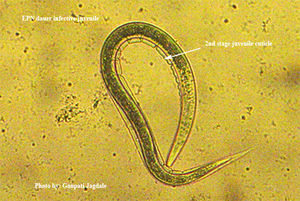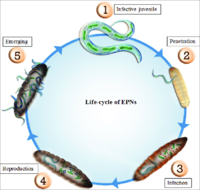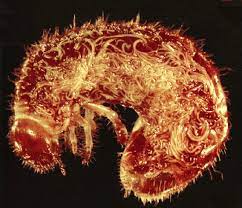Entomopathogenic Nematodes: Difference between revisions
No edit summary |
|||
| (19 intermediate revisions by 3 users not shown) | |||
| Line 2: | Line 2: | ||
== Overview == | == Overview == | ||
[[File:wikiimages.jpg|thumb|second stage juvenile entomopathogenic nematode [1] ]] | [[File:wikiimages.jpg|thumb|second stage juvenile entomopathogenic nematode [1] ]] | ||
There are two different families of Entomopathogenic Nematodes known as Heterorhabditidae and Steinernematidae. Both of these families of Nematodes are considered to obligate parasites of insects meaning that they must parasitize their host to survive and reproduce. Entomopathogenic Nematodes are used as biological insecticides in pest management. These nematodes are considered to be non-toxic to humans and have been very beneficial to the Integrated Pest Management for both agricultural and residential use. They can be found naturally in soils but also can be implemented into almost any soil type and be effective at eliminating pests. | There are two different families of Entomopathogenic [[Nematodes]] known as Heterorhabditidae and Steinernematidae. Both of these families of Nematodes are considered to obligate parasites of [[insects]] meaning that they must parasitize their host to survive and reproduce. Entomopathogenic Nematodes are used as biological insecticides in pest management. These nematodes are considered to be non-toxic to humans and have been very beneficial to the Integrated Pest Management for both agricultural and residential use. They can be found naturally in soils but also can be implemented into almost any [[soil]] type and be effective at eliminating pests. | ||
== Description == | == Description == | ||
Entomopathogenic Nematodes are soft-bodied, non-segmented roundworms that parasitize their prey and use their body for homes and their bodily fluids for nutrients. | Entomopathogenic Nematodes are soft-bodied, non-segmented [[roundworms]] that parasitize their prey and use their body for homes and their bodily fluids for nutrients. | ||
== Phenology == | == Phenology == | ||
'''Kingdom''': | '''Kingdom''': [[Animalia]] | ||
---- | ---- | ||
| Line 20: | Line 20: | ||
---- | ---- | ||
'''Family''': Steinernematidae/ Heterorhabditidae | '''Family''': [[Steinernematidae]]/ [[Heterorhabditidae]] | ||
---- | ---- | ||
| Line 26: | Line 26: | ||
---- | ---- | ||
[4] | [4] | ||
== Life Cycle == | == Life Cycle == | ||
Entomopathogenic Nematodes first start their life cycles at the infective juvenile stage of their life. This is before they infect a host and it's the only free living stage of life that occurs during their life cycle. Then the juvenile finds an insect host to infect by entering through any possible natural opening they can find such as spiracles, the mouth of an insect, the anus, or in some less common cases through intersegmental membranes of the cuticle. About 24-48 hours after the nematode infests its prey the host finally dies while the nematodes mature to and adult stage and then reproduce. The host surprisingly does not die from just being infected by the nematode but dies from the intestinal symbiotic bacteria that is released by the nematodes. Depending on available resources after maturation and reproduction inside the host one or more generations may be able to survive inside a singular host[2]. This whole process from the beginning of the juvenile stage where they spend most of their life through adulthood and eventually death is approximately 42-56 days. | [[File:lifecycle.png|200px|thumb|right|Life cycle of Entomopathogenic Nematodes[9]] | ||
Entomopathogenic Nematodes first start their life cycles at the infective juvenile stage of their life. This is before they infect a host and it's the only free living stage of life that occurs during their life cycle. Then the juvenile finds an insect host to infect by entering through any possible natural opening they can find such as spiracles, the mouth of an insect, the anus, or in some less common cases through intersegmental membranes of the cuticle. About 24-48 hours after the nematode infests its prey the host finally dies while the nematodes mature to and adult stage and then reproduce. The host surprisingly does not die from just being infected by the nematode but dies from the intestinal symbiotic bacteria that is released by the nematodes. Depending on available resources after maturation and reproduction inside the host one or more generations may be able to survive inside a singular host[2]. This whole process from the beginning of the juvenile stage where they spend most of their life through adulthood and eventually death is approximately 42-56 days. | |||
== | == Host Selection == | ||
These specific nematodes will either sit and wait till they find a host that they can infect or they will be actively moving and searching for a host they can easily infect[6]. Studies have shown that Entomopathogenic Nematodes use their olfactory bulbs to "sniff" out chemical signals that insects release into the air. These nematodes are most commonly attracted to the carbon dioxide signals emitted by insects. The volatile components released by insect feces are also a common trigger of the olfactory nerve inside these nematodes that allow them to find a host[5]. By using these scents the Nematodes are able to find new hosts generation after generation. | [[File:host(2).jpg|thumb|right| host infected with thousands of entomopathogenic nematodes [10] ]] | ||
These specific nematodes will either sit and wait till they find a host that they can infect or they will be actively moving and searching for a host they can easily infect[6]. Studies have shown that Entomopathogenic Nematodes use their olfactory bulbs to "sniff" out chemical signals that insects release into the air. These nematodes are most commonly attracted to the carbon dioxide signals emitted by insects. The volatile components released by insect feces are also a common trigger of the olfactory nerve inside these nematodes that allow them to find a host[5]. By using these scents the Nematodes are able to find new hosts generation after generation. | |||
== Reproduction == | == Reproduction == | ||
The reproduction stages of life depends on which family of Entomopathogenic Nematode is being observed. In the Steinernematidae family after the juvenile finds a host whether it is live or dead they will develop into either a male or female. In this family of nematodes multiple nematodes need to infect the same host in order to reproduce but once this occurs, then breeding occurs between one of the males and one of the females and the female will then lay their eggs within the host. | The reproduction stages of life depends on which family of Entomopathogenic Nematode is being observed. In the Steinernematidae family after the juvenile finds a host whether it is live or dead they will develop into either a male or female. In this family of nematodes multiple nematodes need to infect the same host in order to reproduce but once this occurs, then breeding occurs between one of the males and one of the females and the female will then lay their eggs within the host. | ||
On the other hand for the Heterorhabditidae family after entering the host they are considered to be self-fertile hermaphrodites. A hermaphroditic nematode has both sex organs that a male and a female would have and therefore does not need to colonize a host with another nematode of the opposite sex. Research shows that this happens more often due to the relative abundance being fairly low for this family so adaptations occurred throughout time[3]. | On the other hand for the Heterorhabditidae family after entering the host they are considered to be self-fertile [[hermaphrodites]]. A hermaphroditic nematode has both sex organs that a male and a female would have and therefore does not need to colonize a host with another nematode of the opposite sex. Research shows that this happens more often due to the relative abundance being fairly low for this family so adaptations occurred throughout time[3]. | ||
== Agricultural Value == | |||
These [[Nematodes]] can act as a biological pesticide. Entomopathogenic Nematodes can control agricultural pests due to mutualistic relationships with bacteria of the genus Xenorhabdus[7]. This bacteria can cause disease in unwanted pests by suppressing both cellular and humoral insect immunity[7]. The most commonly used and most agriculturally effective nematodes were of those from the Steinernematidae/ Heterorhabditidae families[8]. Since Entomopathogenic Nematodes are nontoxic to humans and provide a great ecosystem service to agricultural areas, this field is continues to grow and more information from different countries is being recorded and published[8]. | |||
== References == | == References == | ||
| Line 51: | Line 54: | ||
---- | ---- | ||
[6] https://www.nature.com/articles/s41598-017-06620-2 Author: Tiffany Baiocchi, Grant Lee, Dong-Hwang Choe, and Adler R. Dillman | [6] https://www.nature.com/articles/s41598-017-06620-2 Author: Tiffany Baiocchi, Grant Lee, Dong-Hwang Choe, and Adler R. Dillman | ||
---- | |||
[7] de Brida, A., Rosa, J., Oliveira, C. et al. Entomopathogenic nematodes in agricultural areas in Brazil. Sci Rep 7, 45254 (2017). https://doi.org/10.1038/srep45254 | |||
---- | |||
[8] Catharine M. Mannion, Richard K. Jansson, Comparison of Ten Entomopathogenic Nematodes for Control of Sweetpotato Weevil ([[Coleoptera]]: Apionidae), Journal of Economic Entomology, Volume 85, Issue 5, 1 October 1992, Pages 1642–1650, https://doi.org/10.1093/jee/85.5.1642 | |||
---- | |||
[9]“Figure 1: Mortality OfBombus Terrestrisexposed to Entomopathogenic Nematodes.” doi:10.7717/peerj.1413/fig-1. | |||
---- | |||
[10] https://www.researchgate.net/figure/Entomopathogenic-nematodes-produce-Hhundreds-of-thousands-of-new-juveniles_fig4_263444652 | |||
Latest revision as of 08:13, 6 May 2021
Entomopathogenic Nematodes (Nematoda Rhabditida)
Overview

There are two different families of Entomopathogenic Nematodes known as Heterorhabditidae and Steinernematidae. Both of these families of Nematodes are considered to obligate parasites of insects meaning that they must parasitize their host to survive and reproduce. Entomopathogenic Nematodes are used as biological insecticides in pest management. These nematodes are considered to be non-toxic to humans and have been very beneficial to the Integrated Pest Management for both agricultural and residential use. They can be found naturally in soils but also can be implemented into almost any soil type and be effective at eliminating pests.
Description
Entomopathogenic Nematodes are soft-bodied, non-segmented roundworms that parasitize their prey and use their body for homes and their bodily fluids for nutrients.
Phenology
Kingdom: Animalia
Phylum: Nematoda
Class: Chromadorea
Order: Rhabditida
Family: Steinernematidae/ Heterorhabditidae
Genus: Steinernema/ Heterohabditis
[4]
Life Cycle

Entomopathogenic Nematodes first start their life cycles at the infective juvenile stage of their life. This is before they infect a host and it's the only free living stage of life that occurs during their life cycle. Then the juvenile finds an insect host to infect by entering through any possible natural opening they can find such as spiracles, the mouth of an insect, the anus, or in some less common cases through intersegmental membranes of the cuticle. About 24-48 hours after the nematode infests its prey the host finally dies while the nematodes mature to and adult stage and then reproduce. The host surprisingly does not die from just being infected by the nematode but dies from the intestinal symbiotic bacteria that is released by the nematodes. Depending on available resources after maturation and reproduction inside the host one or more generations may be able to survive inside a singular host[2]. This whole process from the beginning of the juvenile stage where they spend most of their life through adulthood and eventually death is approximately 42-56 days.
Host Selection

These specific nematodes will either sit and wait till they find a host that they can infect or they will be actively moving and searching for a host they can easily infect[6]. Studies have shown that Entomopathogenic Nematodes use their olfactory bulbs to "sniff" out chemical signals that insects release into the air. These nematodes are most commonly attracted to the carbon dioxide signals emitted by insects. The volatile components released by insect feces are also a common trigger of the olfactory nerve inside these nematodes that allow them to find a host[5]. By using these scents the Nematodes are able to find new hosts generation after generation.
Reproduction
The reproduction stages of life depends on which family of Entomopathogenic Nematode is being observed. In the Steinernematidae family after the juvenile finds a host whether it is live or dead they will develop into either a male or female. In this family of nematodes multiple nematodes need to infect the same host in order to reproduce but once this occurs, then breeding occurs between one of the males and one of the females and the female will then lay their eggs within the host. On the other hand for the Heterorhabditidae family after entering the host they are considered to be self-fertile hermaphrodites. A hermaphroditic nematode has both sex organs that a male and a female would have and therefore does not need to colonize a host with another nematode of the opposite sex. Research shows that this happens more often due to the relative abundance being fairly low for this family so adaptations occurred throughout time[3].
Agricultural Value
These Nematodes can act as a biological pesticide. Entomopathogenic Nematodes can control agricultural pests due to mutualistic relationships with bacteria of the genus Xenorhabdus[7]. This bacteria can cause disease in unwanted pests by suppressing both cellular and humoral insect immunity[7]. The most commonly used and most agriculturally effective nematodes were of those from the Steinernematidae/ Heterorhabditidae families[8]. Since Entomopathogenic Nematodes are nontoxic to humans and provide a great ecosystem service to agricultural areas, this field is continues to grow and more information from different countries is being recorded and published[8].
References
[1] bugsforgrowers.com picture taken by G.B Jagdale, 2015
[2] http://entnemdept.ufl.edu, Author: Nastaran Tofangsaz
[3] https://www.ncbi.nlm.nih.gov/pmc/articles/PMC3578460/ Author: Christine T. Griffin
[4] https://en.wikipedia.org/wiki/Entomopathogenic_nematode
[6] https://www.nature.com/articles/s41598-017-06620-2 Author: Tiffany Baiocchi, Grant Lee, Dong-Hwang Choe, and Adler R. Dillman
[7] de Brida, A., Rosa, J., Oliveira, C. et al. Entomopathogenic nematodes in agricultural areas in Brazil. Sci Rep 7, 45254 (2017). https://doi.org/10.1038/srep45254
[8] Catharine M. Mannion, Richard K. Jansson, Comparison of Ten Entomopathogenic Nematodes for Control of Sweetpotato Weevil (Coleoptera: Apionidae), Journal of Economic Entomology, Volume 85, Issue 5, 1 October 1992, Pages 1642–1650, https://doi.org/10.1093/jee/85.5.1642
[9]“Figure 1: Mortality OfBombus Terrestrisexposed to Entomopathogenic Nematodes.” doi:10.7717/peerj.1413/fig-1.